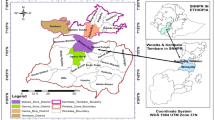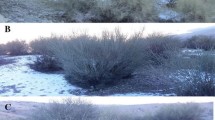Abstract
Biodiversity of arbuscular mycorrhizal colonization and spore population was investigated in different agroforestry trees and crop species collected from different locations of Dinajpur district of Bangladesh. Roots and rhizosphere soils of Albizia procera Benth., Capsicum frutescens L, Curcuma domestica Vahl., Dalbergia sissoo Roxb. and Swietenia macrophylla King. from Dashmail; C. domestica, D. sissoo, Eucalyptus camaldulensis Dehnn., Gmelina arborea (Roxb) DC and Oryza sativa L. from Kantaji and C. domestica, D. sissoo, Litchi chinensis Sonn. and O. sativa from Ramsagar were collected. Roots and soils were assessed following standard methods. The range of AM colonization was recorded 36%–79% from Dashmail. The highest AM colonization was recorded in C. frutescens (79%) and the lowest was in C. domestica (36%). The range of colonization was recorded as 33%–70% from Kantaji. The highest AM colonization was recorded in G. arborea (70%) and the lowest was in O. sativa (33%). The range of AM colonization was recorded as 35%–70% from Ramsagar. The highest AM colonization was recorded in D. sissoo (70%) and the lowest was in O. sativa (35%). Arbuscular mycorrhizal spore population varied from 54 to 140/100g dry soil in the soils from Dashmail. The highest was in the soils of D. sissoo (140) and the lowest was in C. domestica (54). The spore population varied from 63 to 221 in Kantaji. The highest was in G. arborea (221) and the lowest was in O. sativa (63). The range population in Ramsagar varied from 69 to 160. The highest was recorded in D. sissoo (160) and the lowest was in L. chinensis (69). No significant relationship of soil pH and soil OM with AM colonization and with spore population was observed. Simpson’s index of diversity (Ds) and Shannon’s index of diversity-(Hs) were highest in the soil of D. sissoo from Kantaji and the lowest in the soils of O. sativa from Ramsagar. Biodiversity of AM colonization, spore population and the distribution of AM fungi in the rhizosphere soils of different agroforestry plants indicated the occurrence of AM fungi, mycotrophic nature of the trees and crop species, contribution and necessity of AM fungi and the AM dependence of the agroforestry plants growing in Dinajpur district of Bangladesh.
Similar content being viewed by others
References
Abbott, L.K. and Robson, A.D. 1991. Factors influencing the occurrence of vesicular arbuscular mycorrhizas. Agriculture Ecosystem and Environment, 35: 121–150.
Ahmed, M. F.U., 2001. Agroforestry in Bangladesh with special reference to northern Bangladesh. In: Haq, M. F., Hasan, M. K., Asaduzzaman, S. M., Ali, M.Y. (eds.), Development of agroforestry research in Bangladesh, Proceedings of a national workshop held on September 16–17, 2001 held in Gazipur, Bangladesh. p.1–10.
Allen, M.F. and Boosalis, M.G. 1983. Effects of two species of vesicular arbuscular mycorrhizal fungi on draught tolerance of winter wheat. New Phytologist, 93: 67–76.
Bentley, W. R., 1993. Essential concept of agroforestry as practiced in South Asia. In: Bentley, W.R., Khosla, P.K., Seckler, K. (eds.). Agroforestry in South Asia: problems and applied research perspectives. Winrock International, USA and Oxford & IBH publishing CO. Pvt. Ltd. New Delhi. pp.3–12.
Brundrett, M.C. 2002. Coevolution of roots and mycorrhizas of land plants. New Phytologist, 154: 275–304.
Chowdhury, M. S., Khan, M. N., Malek, S. K., 1969. Manual of elementary soil experiments. 500/S. Dhanmondi R/A., Dhaka-2, p.107.
Chaurasia, B., Pandey, A. and Palni, L.M.S. 2005. Distribution, colonization, and diversity of arbuscular mycorrhizal fungi associated with central Himalayan rhododendrons. Forest Ecology and Management, 207: 315–325.
Dhar, P. P. and Mridha, M.A.U. 2003. Status of biodiversity of arbuscular mycorrhizal fungi in different tree species growing in Betagi Community Forests. The Chittagong University Journal of Science, 27: 13–20.
Dhar, P. P. and Mridha, M.A.U. 2006. Biodiversity of arbuscular mycorrhizal fungi in different trees of madhupur forest, Bangladesh. Journal of Forestry Research, 17: 201–205.
Fontenla, S., Godoy, R., Rosso, P. and Havrylenko, M. 1998. Root association in Astrocedrus forests and seasonal dynamics of arbuscular mycorrhizas. Mycorrhiza, 8:29–33.
Francis, R.A. and Read, D.J. 1984. Direct transfer of Carbon between plants connected by vesicular arbuscular mycorrhizal mycelium. Nature (London). 307: 53–56.
Gerdemann, J.W. and Nicolson, T.H., 1963. Spores of mycorrhizal endogone species extracted from soil by wet sieving and decanting. Transaction of British Mycological Society, 46: 235–244.
Hassan, M.M. 1999. Soils of Bangladesh. Published by Salam, M. Chairman, Resource management and infrastructure development consultants and allied agro industries. Dhaka-1213, Bangladesh. p.194.
Louis, L. and Lim, G. 1987. Spore density and root colonization of vesicular arbuscular mycorrhizas in tropical soils. Transaction of British Mycological Society, 88: 207–212.
Mridha, M.A.U. and Rahman, S. 2001. Mycorrhizal status of some agroforestry trees in Bangladesh. In: Haq, M.F., Hasan, M.K., Asaduzzaman, S.M., Ali, M.Y. (eds.), Development of agroforestry research in Bangladesh, Proceedings of a national workshop held on September 16–17, 2001 held in Gazipur, Bangladesh. pp. 153–158.
Muthukumar, T. and Udaiyan, K., 2000. Arbuscular mycorrhizas of plants growing in the western ghat region, Southern India. Mycorrhiza, 9: 297–313.
O’Connor, P.J., Smith, S.E. and Smith, F.A. 2001. Arbuscular mycorrhizal associations in the Southern Desert. Australian Journal of Botany, 49: 493–499.
Pande, M., and Tarafder, J.C. 2004. Arbuscular mycorrhizal fungal diversity in neem based agroforestry systems in Rajasthan. Applied Soil Ecology, 26: 233–241.
Phillips, J.M. and Hayman, D.S. 1970. Improved procedures for clearing roots and staining parasitic and vesicular arbuscular mycorrhizal fungi for rapid assessment of infection. Transaction of British Mycological Society, 55: 158–161.
Sharma, S.K., Sharma, G.D. and Mishra, R.R. 1986. Status of mycorrhizae in subtropical forest ecosystems of Meghalaya. Acta Botanica India, 14: 87–92.
Schenck, N.C. and Perez, Y. 1990. Manual for the identification of VA mycorrhizal fungi. (3rd edition). University of Florida, Gainesville, USA.
Sieverding, E. 1991. Vesicular arbuscular mycorrhizae management in tropical agrosystems. Deutsche Gesellschaft fur technische Zusammenarbeit (GTZ) GmBH, Eschborn, p.371.
van Kassel, C., Singleton, P.W. and Hoben H.J. 1985. Enhanced N-transfer from soybean to maize by vesicular arbuscular mycorrhizal (VAM) fungi. Plant Physiology, 79: 562–563.
Vivekandan, M. and Fixen, P.E. 1991. Cropping system effects on mycorrhizal colonization, early growth and phosphorus uptake of corn. Journal of Soil Science Society America, 55: 136–140.
Author information
Authors and Affiliations
Corresponding author
Additional information
Electronic supplementary material is available in the online version of this article at http://dxdoi.org/10.1007/s11676-007-0018-8
Biography: P. P. Dhar, male, associate professor in the Department of Botany, University of Chittagong, Chittagong-4331, Bangladesh.
Rights and permissions
About this article
Cite this article
Mridha, M.A.U., Dhar, P.P. Biodiversity of arbuscular mycorrhizal colonization and spore population in different agroforestry trees and crop species growing in Dinajpur, Bangladesh. J. of For. Res. 18, 91–96 (2007). https://doi.org/10.1007/s11676-007-0018-8
Received:
Accepted:
Issue Date:
DOI: https://doi.org/10.1007/s11676-007-0018-8




